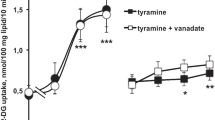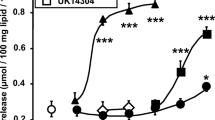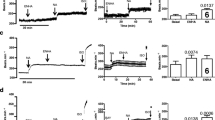Summary
The effect of COMT-inhibitors (U-0521, H 22/54) on lipolysis and on vascular responses induced by noradrenaline, isoprenaline and nerve stimulation in canine adipose tissue in situ has been studied.
COMT inhibition, before or after β-adrenoceptor blockade, did not influence the α-adrenoceptor mediated vasoconstriction due to nerve stimulation (2–5 Hz). Vasoconstriction due to close i.a. noradrenaline was unaffected at a dose of 2×10−10 moles but at a dose of 10−9 moles the peak vasoconstriction was enhanced but the duration of the response was not changed. Prior β-adrenoceptor blockade did not alter the responses to U-0521.
After α-adrenoceptor blockade with Hydergine (120–300 μg i.a.) a vasodilatation was induced by noradrenaline 2×10−10 mole. This response and that produced by isoprenaline (2×10−11 or 10−10 moles) were enhanced after U-0521-treatment, but the vasodilating response to nerve stimulation (2 Hz) after α-adrenoceptor blockade was unaffected.
Lipolysis induced by nerve stimulation or noradrenaline in vivo was increased 50% and that induced by isoprenaline was increased 100% by COMT inhibition. U-0521 did not alter basal lipolysis in vitro but enhanced lipolysis induced by 0.1 μM noradrenaline significantly, both in the presence and in the absence of theophylline.
The present results shows that COMT influences the effective concentration of isoprenaline more than that of noradrenaline. In the vasculature the effects of exogenous noradrenaline is influenced to a larger degree than those induced by nerve stimulation. However, COMT blockade increased lipolysis induced by equieffective doses of exogenous noradrenaline and nerve stimulation to an equal extent. These results are in agreement with the idea that COMT is of physiological importance mainly at receptor sites that are not in close contact with sympathetic nerve endings and supports the idea that vascular α-adrenoceptors are innervated receptors. Vascular β-adrenoceptors on the other hand seem to be humoral receptors unrelated to sympathetic nerve endings and preferentially stimulated by circulating noradrenaline. The β-adrenoceptors on the fat cells may be of both types, i.e. innervated and humoral.
Similar content being viewed by others
References
Ballard, K., Malmfors, T., Rosell, S.: Adrenergic innervation and vascular patterns in canine adipose tissue. Microvasc. Res. 8, 164–171 (1974)
Belfrage, E., Rosell, S.: The role of neuronal uptake at α- and β-adrenoceptor sites in subcutaneous adipose tissue. Naunyn-Schmiedeberg's Arch. Pharmacol. 294, 9–15 (1976)
Bevan, J. A., Su, C.: Sympathetic mechanisms in blood vessels: nerve and muscle relationships. Ann. Rev. Pharmacol. 13, 269–285 (1973)
Bönisch, H., Uhlig, W., Trendelenburg, U.: Analysis of the compartments involved in the extraneuronal storage and metabolism of isoprenaline in the perfused heart. Naunyn-Schmiedeberg's Arch. Pharmacol. 283, 223–244 (1974)
Brandâo, F.: A comparative study of the role played by some inactivation pathways in the disposition of the transmitter in the rabbit aorta and the saphenous vein of the dog. Blood Vessels 13, 309–318 (1976)
Carlsson, A., Corrodi, H., Waldeck, B.: 253. α-Substituierte Dopacetamide als Hemmer der Catechol-O-Methyl-Transferase und der enzymatischen Hydroxylierung aromatischer Aminosäuren in den Catecholamin-Metabolismus eingreifende Substanzen. Helv. Chim. Acta 46, 2271–2285 (1963)
Fredholm, B. B.: Studies on the sympathetic regulation of circulation and metabolism in isolated canine subcutaneous adipose tissue. Acta Physiol. Scand., Suppl. 354 (1970)
Fredholm, B. B., Rosell, S.: Fate of 3H-noradrenaline in canine subcutaneous adipose tissue. Acta Physiol. Scand. 80, 404–411 (1970)
Giles, R. E., Miller, J. W.: A comparison of certain properties of catechol-o-methyl transferase to those of adrenergic beta receptors. J. Pharmacol. Exp. Ther. 156, 201–206 (1967)
Gillis, C. N.: Inactivation of norepinephrine released by electrical stimulation of rabbit aorta in a gaseous medium. Proc. Symp. Physiol. Pharmacol. Vasc. Neuroeffector Systems, Interlaken 1969, pp. 47–52. Basel: Karger: 1971
Graefe, K.-H., Trendelenburg, U.: The effect of hydrocortison on the sensitivity of the isolated nictitating membrane to catecholamines. Relationship to extra-neuronal uptake and metabolism. Naunyn-Schmiedeberg's Arch. Pharmacol. 286, 1–48 (1974)
Guimarâes, S., Paiva, M. A.: The role played by the extraneuronal system in the disposition of noradrenaline and adrenaline in vessles. Naunyn-Schmiedeberg's Arch. Pharmacol. 296, 279–287 (1977)
Guldberg, H. C., Marsden, C. A.: Catechol-O-methyl transferase: pharmacological aspects and physiological role. Pharmacol. Rev. 27, 135–206 (1975)
Horst, W. D., Gattanell, P., Urbano, S., Sheppard, H.: Catechol-O-methyl transferase in erythrocytes and fat cells. Life Sci. 8, 473–476 (1969)
Kalsner, S.: Sensitization of effector responses by modification of agonist disposition mechanisms. Can. J. Physiol. Pharmacol. 54, 177–187 (1976)
Kalsner, S., Nickerson, M.: Disposition of norepinephrine and epinephrine in vascular tissue, determined by the technique of oil immersion. J. Pharmacol. Exp. Ther. 165, 152–165 (1969)
Kaumann, A. J.: Adrenergic receptors in heart muscle: relations among factors influencing the sensitivity of the cat papillary muscle to catecholamines. J. Pharmacol. Exp. Ther. 173, 383–398 (1970)
Kirpekar, S. M.: Factors influencing transmission at adrenergic synapses. Prog. Neurobiol. 4, 163–210 (1975)
Laurell, S., Tibbling, G.: An enzymatic fluorometric micromethod for the determination of glycerol. Clin. Chim. Acta 13, 317–322 (1966)
Levin, J. A., Furchgott, R. F.: Interactions between potentiating agents of adrenergic amines in rabbit aortic strips. J. Pharmacol. Exp. Ther. 172, 320–331 (1970)
Ngai, S. H., Rosell, S., Wallenberg, L.: Nervous regulation of blood flow in the subcutaneous adipose tissue in dogs. Acta Physiol. Scand. 68, 397–403 (1966)
Rosell, S.: Release of free fatty acids from subcutaneous adipose tissue in dogs following sympathetic nerve stimulation. Acta Physiol. Scand. 67, 343–351 (1966)
Rosell, S., Belfrage, E.: Adrenergic receptors in adipose tissue and their relation to adrenergic innervation. Nature 253, 738–739 (1975)
Traiger, G. J., Calvert, D. N.: O-methylation of 3H-norepinephrine by epidydimal adipose tissue. Biochem. Pharmacol. 18, 109–117 (1969)
Trendelenburg, U., Höhn, D., Graefe, K.-H., Pluchino, S.: The influence of block of catechol-o-methyl transferase on the sensitivity of isolated organs to catecholamines. Naunyn-Schmiedeberg's Arch. Pharmacol. 271, 59–92 (1971)
Wyse, D. G.: Inactivation of neural and exogenous norepinephrine in rat tail artery studied by the oil immersion technique. J. Pharmacol. Exp. Ther. 198, 102–111 (1976)
Author information
Authors and Affiliations
Rights and permissions
About this article
Cite this article
Belfrage, E., Fredholm, B.B. & Rosell, S. Effect of catechol-O-methyl-transferase (COMT) inhibition on the vascular and metabolic responses to noradrenaline, isoprenaline and sympathetic nerve stimulation in canine subcutaneous adipose tissue. Naunyn-Schmiedeberg's Arch. Pharmacol. 300, 11–17 (1977). https://doi.org/10.1007/BF00505074
Received:
Accepted:
Issue Date:
DOI: https://doi.org/10.1007/BF00505074




